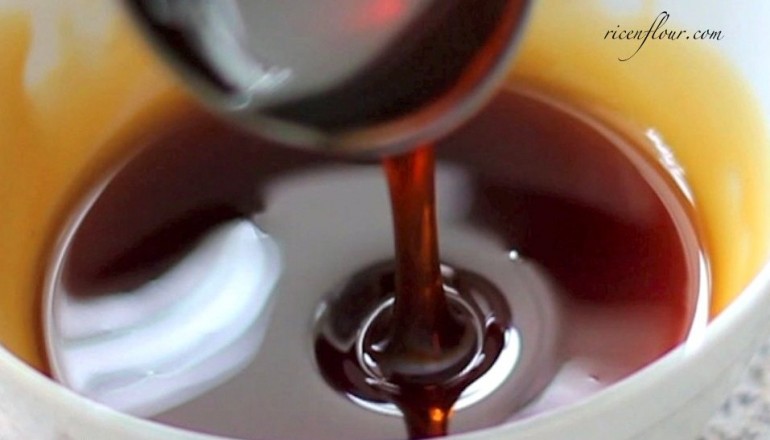Mid-Autumn Festival 2016 is coming. For this very special occasion, Rice n’ Flour will be introducing a series of how to make mooncakes. Prior to making the mooncakes, you will need to make ahead the salted egg yolks and golden syrup, as both need curing and ‘resting’ time respectively.
Check out this post for how to make your own salted eggs at home. If you want to know how to make baked mooncakes as well as learn a bit more about Mid-Autumn Festival in Vietnam, click here.
How to Make Golden Syrup
What is golden syrup? It is a type of inverted sugar syrup that is pretty commonly used in traditional Asian desserts, especially in mooncakes. As implied by the name, it has a beautiful golden colour, a rich and sweet aroma and a creamy honey-like texture.
If you are also wondering why it is called ‘inverted syrup’, it has to do with a chemical reaction which I am not going to try to understand and explain in details here. To put it simply, inversion happens when you boil sugar in water for a long time, and some acid is usually added to speed up the process. Inverted syrup is valued by bakers because it is an effective sweetener and better at retaining moisture in pastries than simple sugar, and also improves shelf-life of the baked goods.
Therefore, golden syrup is one of the most important ingredients in mooncake dough, determining its sweetness, softness, colour and shelf life. Golden syrup is usually prepared very early on prior to the actual making of mooncakes. When left for a period of time, the syrup will thicken, become darker and more flavourful, contributing to the golden brown appearance and the tender texture of the dough.
There is a common myth that golden syrup needs to be made several months or even up to one year prior to making mooncakes, as you should allow some time for the syrup to ‘rest’ and thicken. However, golden syrup made anywhere between 10 to 14 days before making mooncakes can definitely be used without compromising the quality of the final product. So, don’t freak out if you haven’t started making the syrup yet, you still have plenty of time until the Mid-Autumn Festival 
10-day-old golden syrup
Making your own golden syrup is not too difficult and time-consuming, yet your homemade syrup is definitely superior in quality, and you know exactly what goes into it, unlike the processed syrup sold in supermarkets. All you need is sugar, water, and lemon (or pineapple). You can also add maltose and lye water but they are optional.
After several trials and errors with different types of sugar and different recipes, these are some helpful tips that I gather:
1. Sugar: you can use almost any kind of sugar – white or brown. It is best not to use palm sugar; because the palm taste may be too strong. If you don’t have a lot of time to prepare the sugar syrup ahead, I would recommend using brown sugar since it will produce a darker-coloured syrup than using white sugar. And above all, use trusted brands that guarantee purified sugar that is free of residues; otherwise, a lot of foams may build up while you make the syrup, and the final product may turn out to be not as clear and shiny as desired.
2. Lemon (or Pineapple): the juice from lemon or pineapple contains acid and will help prevent the crystallization of the sugar (liquid syrup converting back to solid-state sugar). In addition, it also gives a delicate fruity aroma to the syrup. You can also substitute by using lime, but lemon and pineapple are the best options.
3. Maltose: Also known as malt syrup, maltose can be found in most Asian supermarkets. At room temperature, it is very thick and almost solid, and only becomes runny when heated. It is not as sweet as simple sugar and is used primarily to give a glossy look to the product, therefore it is optional in this recipe.
4. Lye water: Also known as alkaline water, alkaline salt, or kansui (in Chinese). It is an alkaline solution and therefore some people say it is a must-have in Chinese mooncakes, as it neutralizes the acid from lemon or pineapple juice, resulting in a sweet pastry with no sourness, and determines the colour of the mooncake skin. But I have tried recipes with and without lye water and found that there is not much difference in the final products. As lye water is corrosive, it can be dangerous when used in excessive amount and definitely needs to be kept out of reach from children. If you are concerned about the use of lye water in foods, feel free to omit this out of the recipe.
INGREDIENTS
- 1 kilogram sugar (white or brown) – I used ½ white and ½ brown
- 600 ml water
- 60 – 70 grams lemon (1 medium sized lemon)
- 30 ml maltose (optional)
- 5 ml (1 tsp) lye water + 20 ml water (optional)
*Note:
This recipe makes 1.1 – 1.2 kg golden syrup. On average, I use about 150 grams golden syrup to make 450 grams mooncake dough. The weight of mooncake skin is usually about 1/3 of the whole cake. From this ratio, you can figure the amount of dough needed for different types of mould used (50 gram, 75 gram, 150 gram, etc.)
For example: If you use a 75 gram cake mould, the skin should weigh: 75 : 3 = 25 gram (filling would be 50 gram). So, a 450 gram dough using 150 gram golden syrup will give you: 450 : 25 = 18 cakes. Hence, with 1 kg of syrup, you can make: 18 x (1000 : 150) = 120 of 75-gram mooncakes.
INSTRUCTIONS
A detailed recipe with all the specific notes is available on Savoury Days’ YouTube Channel (subscribe to get all the newly uploaded recipes) in both English and Vietnamese. Check it out at this link or the video right below. Don’t forget to turn on HD setting for best quality.
1. Wash the lemon, squeeze out all the juice. Remove the seeds but don’t throw away the peel just yet.
2. Boil water. In an empty saucepan, add in sugar. Pour in boiling water and stir to dissolve the sugar.
3. Put the saucepan on high heat until water starts boiling. Lower heat to simmer and remove any foam on top.
4. Add in lemon juice and lemon peel. Cook at low heat for 50 – 65 minutes.
– During the entire cooking process, DO NOT STIR to prevent sugar crystallization. There is no need to stir when adding in lemon juice as it will dissolve itself.
– If using maltose or lye water, add them in 30 – 40 minutes after adding lemon juice. Lye water needs to be diluted with water beforehand.
– During the cooking process, you can use a clean damp towel to wipe away sugar that sticks on the side of the pan. However you need to be very careful to prevent these sugar granules from falling into the pan. If you really feel like you won’t be able to clean it well, feel free to omit this step.
– If there is too much foam building up, use a clean spoon, gently remove as much foam as you can.
5. The most important thing to keep in mind is to control the cooking time so that the syrup is at its best quality. Syrup that is too runny will make the mooncake dough too soft, which may cause the cake to lose its shape while baking. On the other hand, syrup that is too thick will result in a dry dough; hence the mooncake skin may be too hard or too flaky.
Depending on the stove, cooking time will vary. After 40 – 45 minutes from the time the sugar syrup starts boiling, you can check if the syrup is done by following any of these methods:
- Take a little bit of the syrup and drop it, from a very close distance, onto a flat plate. If the syrup spreads out immediately, it needs more cooking. If the syrup solidifies, it is over-cooked. The syrup is perfect when it spreads out just a little bit for 1 or 2 seconds, but maintaining its round shape.
- Prepare a small bowl of water; put a few drops of syrup in. If the syrup dissolves right away in water, it needs more cooking. If the syrup solidifies into small clumps, it is over-cooked. The syrup is perfect when it falls to the bottom of the bowl and thins out into sphere shape.
- Measure the weight of the saucepan beforehand. After cooking, weigh the pot and the syrup. Subtract this number with the weight of the pot to get the weight of the syrup. From 1kg of sugar and 600 ml of water, if the weight of the syrup is around 1.2 kg, it is perfect.
If the syrup is too runny, increase cooking time. If the syrup is too thick (which can be caused by high heat that results in faster water evaporation), add in more water and continue cooking.
6. When the syrup has reached the desired consistency, remove it from heat. Discard the lemon peel, and let cool. Prepare a clean mason jar (sterile it in boiling water first and wipe dry). Using a spoon or a ladle, transfer the syrup into the jar. If you pour it from the pot, you will also take in sugar particles around the side of the pot, which may cause crystallization of sugar later on.
Let the syrup cool down completely before closing the lid. It is ready to use after 7 to 10 days but the longer it is kept, the better its quality will be.
The picture below shows the syrup that I have made from white sugar (left side) and ½ white + ½ brown (right side). Both yield very good results when I used them after 2 weeks of storage. Of course, the right side jar gives a darker coloured mooncakes.
Common failures & Solutions
- If the golden syrup solidifies after it has cooled down, the syrup has been over-cooked. To solve this, you can let the jar sit for a while in warm water for the syrup to liquefy, and then pour the syrup into a pot, add more water and cook until you get the desired consistency.
- If you start noticing sugar particles forming inside the jar, put the syrup back on the stove, add in some lemon juice and cook.
- If after a period of time, you start noticing a layer of sugar at the bottom of the jar, this is sugar crystallization. Some people say if the syrup gets to this stage, it cannot be used anymore. But I think you can still let the jar sit for a while in warm water, put in back on stove, add water and lemon juice and re-cook it. I have not yet encountered this incident so, if this ever happens to you and you discover a solution, leave a comment below, I would be delighted to know!
Now that your golden syrup and salted eggs are ready, are you all set to make mooncakes?
——————————–——————————–
- Recipe & Photos: Linh Trang
- Written by: San Lương
- Edited by: Thảo Đan






Hello what if the syrup is cooked perfectly but still runny do you recommend cooking it a little more..??